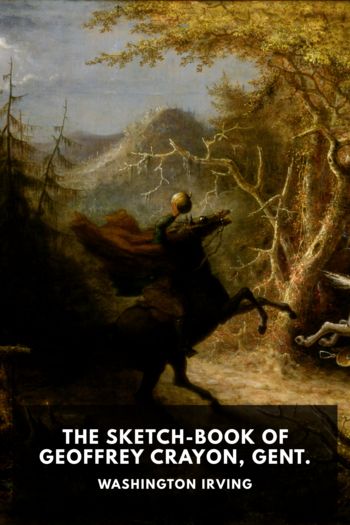The Sketch-Book of Geoffrey Crayon, Gent., Washington Irving [best manga ereader .txt] 📗

- Author: Washington Irving
Book online «The Sketch-Book of Geoffrey Crayon, Gent., Washington Irving [best manga ereader .txt] 📗». Author Washington Irving
Are strewings fitt’st for graves—
You were as flowers now wither’d; even so
These herblets shall, which we upon you strow. Cymbeline
Among the beautiful and simple-hearted customs of rural life which still linger in some parts of England are those of strewing flowers before the funerals and planting them at the graves of departed friends. These, it is said, are the remains of some of the rites of the primitive church; but they are of still higher antiquity, having been observed among the Greeks and Romans, and frequently mentioned by their writers, and were no doubt the spontaneous tributes of unlettered affection, originating long before art had tasked itself to modulate sorrow into song or story it on the monument. They are now only to be met with in the most distant and retired places of the kingdom, where fashion and innovation have not been able to throng in and trample out all the curious and interesting traces of the olden time.
In Glamorganshire, we are told, the bed whereon the corpse lies is covered with flowers, a custom alluded to in one of the wild and plaintive ditties of Ophelia:
White his shroud as the mountain snow
Larded all with sweet flowers;
Which be-wept to the grave did go,
With true love showers.
There is also a most delicate and beautiful rite observed in some of the remote villages of the south at the funeral of a female who has died young and unmarried. A chaplet of white flowers is borne before the corpse by a young girl nearest in age, size, and resemblance, and is afterwards hung up in the church over the accustomed seat of the deceased. These chaplets are sometimes made of white paper, in imitation of flowers, and inside of them is generally a pair of white gloves. They are intended as emblems of the purity of the deceased, and the crown of glory which she has received in heaven.
In some parts of the country, also, the dead are carried to the grave with the singing of psalms and hymns—a kind of triumph, “to show,” says Bourne, “that they have finished their course with joy, and are become conquerors.” This, I am informed, is observed in some of the northern counties, particularly in Northumberland, and it has a pleasing, though melancholy effect to hear of a still evening in some lonely country scene the mournful melody of a funeral dirge swelling from a distance, and to see the train slowly moving along the landscape.
Thus, thus, and thus, we compass round
Thy harmlesse and unhaunted ground,
And as we sing thy dirge, we will,
The daffodill
And other flowers lay upon
The altar of our love, thy stone.
There is also a solemn respect paid by the traveller to the passing funeral in these sequestered places; for such spectacles, occurring among the quiet abodes of nature, sink deep into the soul. As the mourning train approaches he pauses, uncovered, to let it go by; he then follows silently in the rear; sometimes quite to the grave, at other times for a few hundred yards, and, having paid this tribute of respect to the deceased, turns and resumes his journey.
The rich vein of melancholy which runs through the English character, and gives it some of its most touching and ennobling graces, is finely evidenced in these pathetic customs, and in the solicitude shown by the common people for an honored and a peaceful grave. The humblest peasant, whatever may be his lowly lot while living, is anxious that some little respect may be paid to his remains. Sir Thomas Overbury, describing the “faire and happy milkmaid,” observes, “thus lives she, and all her care is, that she may die in the springtime, to have store of flowers stucke upon her winding-sheet.” The poets, too, who always breathe the feeling of a nation, continually advert to this fond solicitude about the grave. In The Maid’s Tragedy, by Beaumont and Fletcher, there is a beautiful instance of the kind describing the capricious melancholy of a brokenhearted girl:
When she sees a bank
Stuck full of flowers, she, with a sigh, will tell
Her servants, what a pretty place it were
To bury lovers in; and made her maids
Pluck ’em, and strew her over like a corse.
The custom of decorating graves was once universally prevalent: osiers were carefully bent over them to keep the turf uninjured, and about them were planted evergreens and flowers. “We adorn their graves,” says Evelyn, in his Sylva, “with flowers and redolent plants, just emblems of the life of man, which has been compared in Holy Scriptures to those fading beauties whose roots, being buried in dishonor, rise, again in glory.” This usage has now become extremely rare in England; but it may still be met with in the churchyards of retired villages, among the Welsh mountains; and I recollect an instance of it at the small town of Ruthven, which lies at the head of the beautiful vale of Clewyd. I have been told also by a friend, who was present at the funeral of a young girl in Glamorganshire, that the female attendants had their aprons full of flowers, which, as soon as the body was interred, they stuck about the grave.
He noticed several graves which had been decorated in the same manner. As the flowers had been merely stuck in the ground, and not planted, they had soon withered, and might be seen in various states of decay; some drooping, others quite perished. They were afterwards to be supplanted by holly, rosemary, and other evergreens, which on some graves had grown to great luxuriance, and overshadowed the tombstones.
There was formerly a melancholy fancifulness in the arrangement of these rustic offerings, that had something in it truly poetical. The rose was sometimes blended with the lily, to form a general emblem of frail mortality. “This sweet flower,” said Evelyn, “borne on a branch set with thorns





Comments (0)